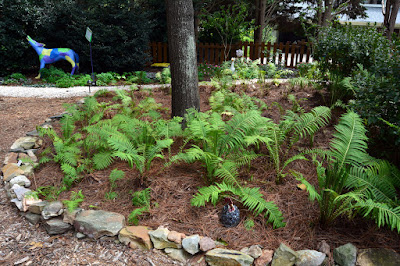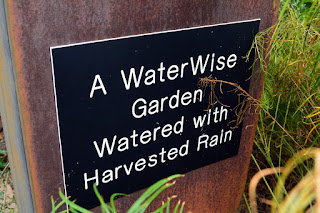Our Gardens Can All Bee Better
No matter what your garden style, we can all be better providing habitat to attract wildlife to our gardens. Too many bees, beneficial insects, birds, mammals and amphibians are at risk due to habitat loss and overuse of pesticides and insecticides. Home gardens are needed now, more than ever, to provide food, host plants, shelter, nesting sites and water sources to ensure their survival. Using organic methods and smart IPM practices will create a productive environment for these fundamental creatures. Being water wise and mindfully choosing plants that are suited for your eco region will build a stronger, healthier environment and promote a wider variety of insects to thrive in your garden. If this sounds like a tall order, just take a look at what these homeowners have created in their suburban gardens.
Gardens on this inaugural tour all shared a common theme, making a difference in their community with gardens that support life.
Growing an organic garden bids native pollinators such as squash bees and bumble bees to visit blooms that will produce delicious vegetables and fruit. Did you know that tomatoes are more productive when pollinated by bumblebees? Or that orchard bees are more effective pollinators of fruit trees than the European honeybees? Most native pollinators are attracted specifically to native plants; however, planting native plants with your fruits and vegetables will help native pollinators work throughout your entire garden.
Foodscape gardens by their very nature support pollinators because the plants, bees, beetles, flies and butterflies are co-dependent. Herbs, vegetables and fruits are grown in raised beds in this organic garden using companion plants, mulch and water-wise practices (they have 10 rain barrels~!). This garden is a community effort. Neighbors often come over and harvest herbs while pulling a few weeds. The neighborhood doesn't have an HOA so they are not restricted in their design requirements and growing their food in the front garden made sense because it provided the necessary light requirements. The beauty of this, is that neighbors have been inspired to build vegetable gardens in their own yards.
If you love conifers, then this landscape is pure inspiration. Packed with a wide variety of evergreens and maples, this garden is a haven for birds. Both migrating and year-round residence find shelter, food and water in this habitat. Two amazing water features meander through the back yard attracting wildlife with its shallow, running water. The stone work and deliberate placement of trees and shrubs really made this garden exceptional.
The texture of the diverse selection of conifers and range of greens provide depth and lushness to the grounds. Seating areas are scattered throughout, allowing visitors to enjoy this birding paradise.The six different maple species, 11 species of pine and 6 species of dogwood support hundreds of different caterpillars. These caterpillars are food for birds, especially during nesting season.
When we visited this next garden, I couldn't help but think the owners had read Lawn Gone written by my friend Pam over at Digging. This garden had no lawn in the front or back yard. Instead, the space is packed full of trees, shrubs, perennials and ground covers that supports local wildlife. It is an excellent example of how we need to move away from the mindset that lawns make a garden. Lots of transitional areas create interest to the space. Massing plants together provide places for the eyes to rest in this design concept.
Not all the plants in this garden are native, demonstrating that friendly ornamentals can be used prudently. Native plants support local wildlife best so consider your plant choices wisely. How will you use your garden real estate to its fullest potential? If you consider non-natives for your garden please do research before you purchase an exotic plant. Ask yourself, is it invasive? (check your local invasive plant council list), Is it harmful to local habitat? (here is an example: Nandina berries kill Cedar Waxwings) Are your local conditions suitable for the plant? (see water wise tips below)
This garden also has artistic pieces incorporated in the landscape. Adding creative elements to a garden can really enhance a space. If done right, plant material can provide a backdrop to showcase the art, or the art can help exhibit foliage and blooms. It is also a nice way to provide seasonal interest.
Sadly, we didn't get to all the gardens on the tour. We took our time in each of the gardens we did visit and stopped for lunch along the way. What I loved about this tour is that all the gardens were focused on being wildlife friendly. These gardens aren't highly manicured; they are habitat gardens, created by people who have a passion to bee better stewards of the environment. Of course everyone had pulled weeds and put down fresh mulch (best way to give your plants the wow factor) but these gardens were alive with wildlife visitors.
Bee Pollinator Friendly
Gardens that support pollinators should include:
-plants that are host and nectar sources for a variety of pollinating insects including bees and wasps, butterflies and moths, flies, beetles
-provide at least one water source
-be situated in sunny areas that include some wind breaks
-create large swaths of native and non-invasive plants that provide continuous bloom throughout the growing season
-eliminate the use of pesticides
Bee Waterwise
"A waterwise design is always a good idea, but right now in the absence of rain, it’s embraceable" ~Helen Yoest, author Gardening with Confidence
-Group plants with similar needs together. There are 3 zones in a water wise garden: oasis, transitional, and xeric. The oasis zone is closest to water source, which could be drain spouts, rain barrel, garden hose or natural water source. The transitional zone is half way between your home and end of your garden. This zone should include plants that are drought tolerant, only requiring supplemental water in extreme conditions. Finally, the xeric zone is at the perimeter of your garden and should be planted with drought resistant plants.
-Include a rain gauge in your garden to monitor your local rainfall. Only water plants if absolutely necessary. Established plants only require an inch of water a week. Containers may need to be watered daily during the hottest months using harvested rain water.
-Mulching your garden with organic matter helps retain moisture and is the best defense in drought conditions.
 |
| Helen's Haven supporting pollinators and bees with habitat friendly practices |
On a recent family visit to the Raleigh/Durham, North Carolina area, I attended the 1st annual Bee Better garden tour. Bee Better is an educational foundation created by my friend extraordinaire, Helen Yoest, author, blogger, gardener, speaker, and promoter of habitat and sustainable garden practices.
 |
| Helen (isn't she adorable!) feeding her chickens |
The goal of Bee Better is to help homeowners build better gardens that support pollinators, birds and other beneficial insects. One of the ways they are sharing their knowledge and ideas is by opening private gardens to locals to demonstrate how this can be done.
 |
| Wasp taking a break on one of the many pollinator friendly plants in Helen's Haven |
Gardens on this inaugural tour all shared a common theme, making a difference in their community with gardens that support life.
 |
| A street view of Helen's Haven |
Growing an organic garden bids native pollinators such as squash bees and bumble bees to visit blooms that will produce delicious vegetables and fruit. Did you know that tomatoes are more productive when pollinated by bumblebees? Or that orchard bees are more effective pollinators of fruit trees than the European honeybees? Most native pollinators are attracted specifically to native plants; however, planting native plants with your fruits and vegetables will help native pollinators work throughout your entire garden.
 |
| Edible garden in front yard (notice the solar panels too!) |
 |
| eye-catching design with conifers |
If you love conifers, then this landscape is pure inspiration. Packed with a wide variety of evergreens and maples, this garden is a haven for birds. Both migrating and year-round residence find shelter, food and water in this habitat. Two amazing water features meander through the back yard attracting wildlife with its shallow, running water. The stone work and deliberate placement of trees and shrubs really made this garden exceptional.
The texture of the diverse selection of conifers and range of greens provide depth and lushness to the grounds. Seating areas are scattered throughout, allowing visitors to enjoy this birding paradise.The six different maple species, 11 species of pine and 6 species of dogwood support hundreds of different caterpillars. These caterpillars are food for birds, especially during nesting season.
 |
| mimicking nature in an artistic design |
When we visited this next garden, I couldn't help but think the owners had read Lawn Gone written by my friend Pam over at Digging. This garden had no lawn in the front or back yard. Instead, the space is packed full of trees, shrubs, perennials and ground covers that supports local wildlife. It is an excellent example of how we need to move away from the mindset that lawns make a garden. Lots of transitional areas create interest to the space. Massing plants together provide places for the eyes to rest in this design concept.
 |
| swath of ostrich ferns allowed to colonize |
 |
| some of the fabulous garden art by local artisans |
This garden also has artistic pieces incorporated in the landscape. Adding creative elements to a garden can really enhance a space. If done right, plant material can provide a backdrop to showcase the art, or the art can help exhibit foliage and blooms. It is also a nice way to provide seasonal interest.
Sadly, we didn't get to all the gardens on the tour. We took our time in each of the gardens we did visit and stopped for lunch along the way. What I loved about this tour is that all the gardens were focused on being wildlife friendly. These gardens aren't highly manicured; they are habitat gardens, created by people who have a passion to bee better stewards of the environment. Of course everyone had pulled weeds and put down fresh mulch (best way to give your plants the wow factor) but these gardens were alive with wildlife visitors.
Some Tips to Bee Better in Your Garden
Bee Pollinator Friendly
Gardens that support pollinators should include:
-plants that are host and nectar sources for a variety of pollinating insects including bees and wasps, butterflies and moths, flies, beetles
-provide at least one water source
-be situated in sunny areas that include some wind breaks
-create large swaths of native and non-invasive plants that provide continuous bloom throughout the growing season
-eliminate the use of pesticides
Bee Waterwise
"A waterwise design is always a good idea, but right now in the absence of rain, it’s embraceable" ~Helen Yoest, author Gardening with Confidence
-Group plants with similar needs together. There are 3 zones in a water wise garden: oasis, transitional, and xeric. The oasis zone is closest to water source, which could be drain spouts, rain barrel, garden hose or natural water source. The transitional zone is half way between your home and end of your garden. This zone should include plants that are drought tolerant, only requiring supplemental water in extreme conditions. Finally, the xeric zone is at the perimeter of your garden and should be planted with drought resistant plants.
-Include a rain gauge in your garden to monitor your local rainfall. Only water plants if absolutely necessary. Established plants only require an inch of water a week. Containers may need to be watered daily during the hottest months using harvested rain water.
-Mulching your garden with organic matter helps retain moisture and is the best defense in drought conditions.




.png)
